お問い合わせ
ダウンロード
マニュアル、データシート、ソフトウェアなどのダウンロード:
フィードバック
Power Measurement Deskew & Calibration Fixture Instructions
This document is targeted to product users and explains operation and/or installation procedures.
該当製品:
TAP1500, TAP2500 0, TAP3500 0, TDP0500, TDP1000, TDP1500 0, P6243, P6245, P6247, P6248, P6251, TCP0150, TCP303, A6312, A6303, TAP4000, P5050B 0, TPP0250, TPP0500 0, TPP1000 0, TDP3500 0, TDP4000, P5200A, P5205A 0, P5210A 0, THDP0200, TMDP0200, THDP0100, TCP0030A, TCP0020, TCP2020, TCP202A, TCP312A, TCP305A
By downloading, you agree to the terms and conditions of the Manuals Download Agreement.
Manuals Download Agreement
ATTENTION: please read the following terms and conditions carefully before downloading any documents from this website. By downloading manuals from Tektronix' website, you agree to the following terms and conditions:
Manuals for Products That Are Currently Supported:
Tektronix hereby grants permission and license to owners of Tektronix instruments to download and reproduce the manuals on this website for their own internal or personal use. Manuals for currently supported products may not be reproduced for distribution to others unless specifically authorized in writing by Tektronix, Inc.
A Tektronix manual may have been revised to reflect changes made to the product during its manufacturing life. Thus, different versions of a manual may exist for any given product. Care should be taken to ensure that one obtains the proper manual version for a specific product serial number.
Manuals for Products That Are No Longer Supported:
Tektronix cannot provide manuals for measurement products that are no longer eligible for long term support. Tektronix hereby grants permission and license for others to reproduce and distribute copies of any Tektronix measurement product manual, including user manuals, operator's manuals, service manuals, and the like, that (a) have a Tektronix Part Number and (b) are for a measurement product that is no longer supported by Tektronix.
A Tektronix manual may be revised to reflect changes made to the product during its manufacturing life. Thus, different versions of a manual may exist for any given product. Care should be taken to ensure that one obtains the proper manual version for a specific product serial number.
This permission and license does not apply to any manual or other publication that is still available from Tektronix, or to any manual or other publication for a video production product or a color printer product.
Disclaimer:
Tektronix does not warrant the accuracy or completeness of the information, text, graphics, schematics, parts lists, or other material contained within any measurement product manual or other publication that is not supplied by Tektronix or that is produced or distributed in accordance with the permission and license set forth above.
Tektronix may make changes to the content of this website or to its products at any time without notice.
Limitation of Liability:
TEKTRONIX SHALL NOT BE LIABLE FOR ANY DAMAGES WHATSOEVER (INCLUDING, WITHOUT LIMITATION, ANY CONSEQUENTIAL OR INCIDENTAL DAMAGES, DAMAGES FOR LOSS OF PROFITS, BUSINESS INTERRUPTION, OR FOR INFRINGEMENT OF INTELLECTUAL PROPERTY) ARISING OUT OF THE USE OF ANY MEASUREMENT PRODUCT MANUAL OR OTHER PUBLICATION PRODUCED OR DISTRIBUTED IN ACCORDANCE WITH THE PERMISSION AND LICENSE SET FORTH ABOVE.
Read Online
Overview
This fixture converts the oscilloscope PROBE COMPENSATION output (Probe Calibration on DPO7000C Series) or the TEK-DPG pulse generator output into a set of test point connections. These connections provide you with a convenient way to compensate for timing differences between voltage and current probes.
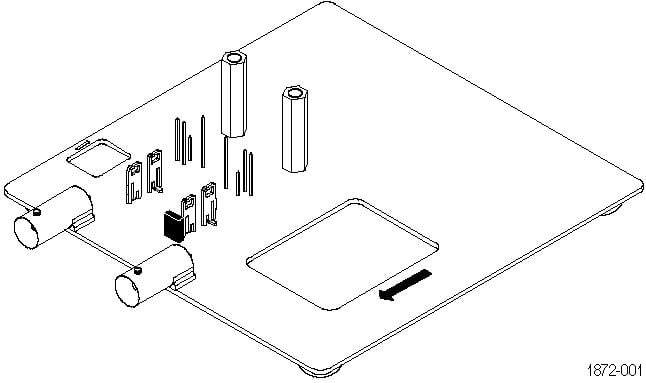
You can also optimize the instrument gain and offset accuracy at the probe tips for both voltage and current probes. Use the table as a guide to connect a variety of Tektronix voltage and current probes together on the fixture.
Connecting to the instrument
The fixture has two BNC inputs, Port A and Port B. The jaw size of the current probes and the operation that you want to perform determine which input to use. Use the included BNC cable to connect the fixture input to the Probe Calibration output of your DPO7000C instrument or to an external generator. Other TekVPI oscilloscope models, including the MDO3000 and MDO4000C series, 3 Series MDO and 4/5/6 Series B MSO, require the TEK-DPG pulse generator or an external generator as the signal source.
 | CAUTION:The maximum allowable voltage applied to either input is 8 V RMS. Voltages in excess of 8 V RMS can damage the fixture. |
Passive voltage probes fixture input guide
The following table supports P6139B, P5050B, TPP0250 TPP0500B, TPP1000, and other 10X passive probes. Not all probes are usable with all instruments. Gain and offset calibration is generally not needed for these probes.
| Operation | Input |
|---|---|
| Low frequency compensation | B |
| Gain and offset calibration (remove jumper from fixture to perform this operation) | B |
| Compensate timing with respect to current probes | A/B (use Port A for small current probes, Port B for large) |
Active voltage probes fixture input guide
The following table supports TAP1500, TAP2500, TAP3500, TAP4000, TDP0500, TDP1000, TDP1500, TDP3500, TDP4000, P6243, P6245, P6247, P6248, and P6251 probes. Not all probes are usable with all instruments.
| Operation | Input |
|---|---|
| Gain and offset calibration (remove jumper from fixture to perform this operation) | B |
| Compensate timing with respect to current probes | A/B (use Port A for small current probes, Port B for large) |
High voltage probes fixture input guide
The following table supports P5200A, P5205A, P5210A (requires external signal source), THDP0200, TMDP0200, and THDP0100 probes. Not all probes are usable with all instruments.
| Operation | Input |
|---|---|
| Gain and offset calibration (remove jumper from fixture to perform this operation) | B |
| Compensate timing with respect to current probes | A/B (use Port A for small current probes, Port B for large) |
Current probes fixture input A guide
The following table supports TCP0030A, TCP0020, TCP2020, TCP202A, TCP312A, and TCP305A probes. Not all probes are usable with all instruments.
| Operation | Input |
|---|---|
| Gain and offset calibration | A |
| Compensate timing with respect to current probes | A |
Current probes fixture input B guide
The following table supports TCP303 and TCP0150 probes. Not all probes are usable with all instruments.
| Operation | Input |
|---|---|
| Gain and offset calibration | B |
| Compensate timing with respect to current probes | B |
Connecting probes
The following diagrams show how to attach each type of probe tip to the fixture. Refer to the ground symbols on the fixture to establish the correct polarity.
 | WARNING:To avoid personal injury, use care while connecting probe tips to the square pins on the fixture. The ends of the square pins are sharp. |
Active Voltage or Differential probes
For Active Voltage probes (TAP1500, TAP2500, TAP3500, TAP4000, P6243, or P6245), connect the probe tip to the short pin and the probe ground to the long pin as shown.
For Differential probes (TDP0500, TDP4000, TDP3500, TDP1000, TDP1500, P6247, P6248, or P6251), connect the probe + input to the signal pin and the probe – input to the ground pin as shown. There is no connection to the probe ground input.
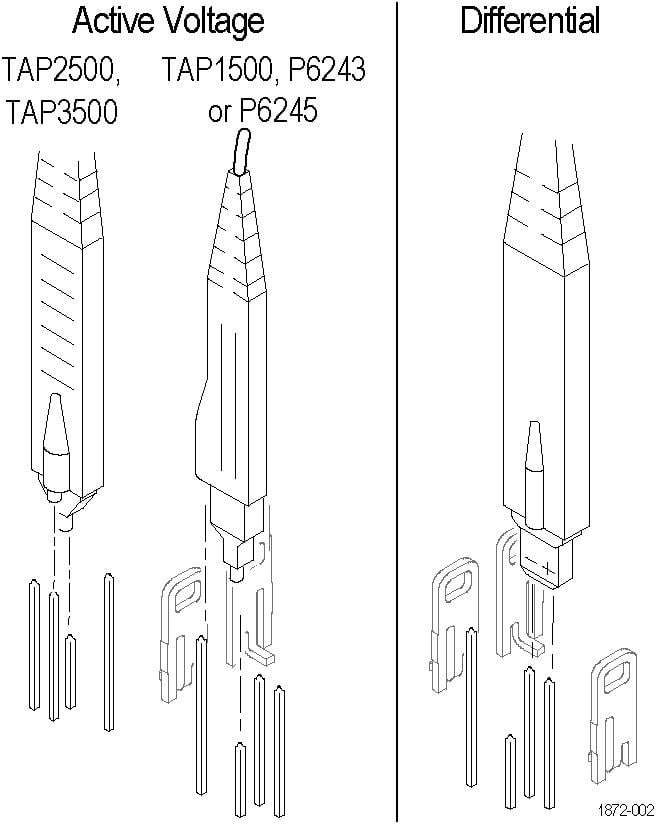
Passive Voltage or High Voltage probes
For P6139B or P5200 Series probes, connect the probe tip and the ground lead to the two terminals as shown.
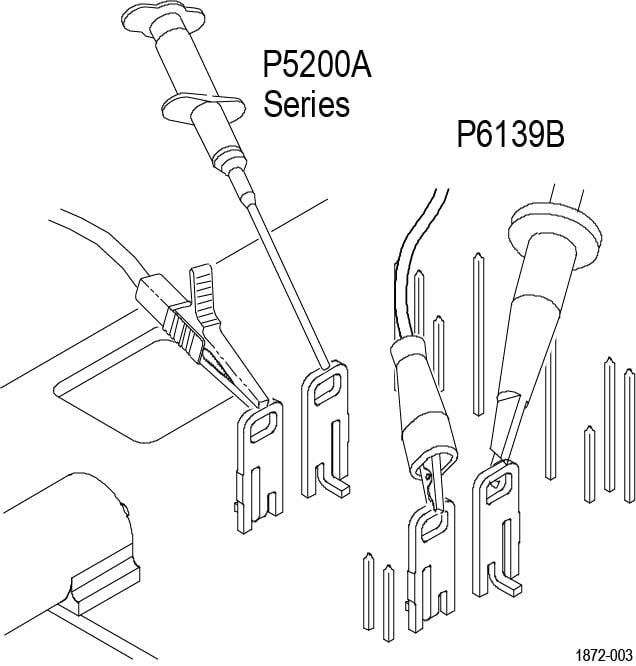
Current probes
For TCP0030A, TCP0020, TCP2020, TCP202A, TCP312A, TCP305A, TCP0150, and TCP303 probes, connect the current probe around the current loop as shown. Be sure to align the polarity arrows on the current probe and the fixture, and make sure the current probe slider is closed and locked.
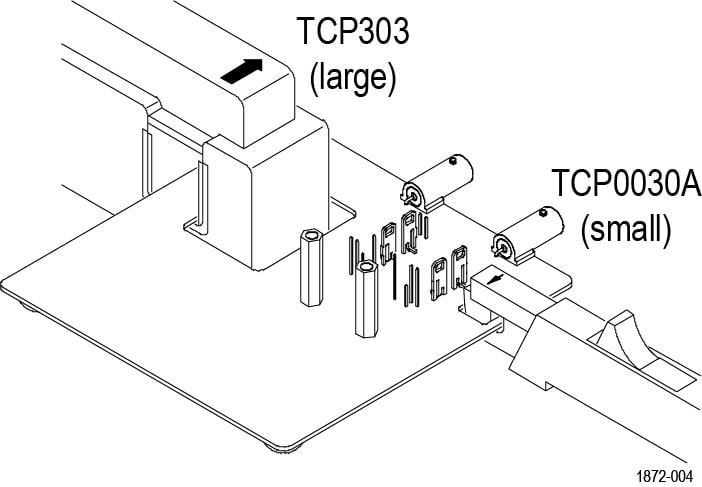
Using the fixture
Perform the following steps to use the fixture. For best results, warm up the equipment for 20 minutes before performing these functions.
Optimize Gain and Offset Accuracy
Not all oscilloscopes support this function.
- Connect the Port A or Port B side of the fixture to the instrument, depending on the probe type. If you are optimizing the gain and offset accuracy for a voltage probe on Port B, remember to remove the small jumper over the two pins on the fixture.
- Connect the probe to the fixture as described in Connecting Probes.
- Initiate the Calibrate Probe routine.
- When the routine is finished, remove the connections and replace the small jumper across the two pins on the fixture. Leave the jumper installed for all other functions.
Compensate probe timing (Deskew)
- Connect the Port A or Port B side of the fixture to the instrument, depending on the probe type.
- Connect the probes to the fixture.
- Display all channels that you want to deskew.
- Push the AUTOSET button on the instrument front panel.
- Adjust vertical SCALE and POSITION for each channel so that the signals overlap and are centered on-screen (with active probes, adjusting offset may be required).
- Adjust horizontal POSITION so that a triggered rising edge is at center screen.
- Adjust horizontal SCALE so that the differences in the channel delays are clearly visible.
- Adjust horizontal POSITION again so that the first rising edge is exactly at center screen. The fastest probe is connected to this channel. The fastest probe is probably the one with the shortest cable or the highest bandwidth.
- Touch the VERT button or use the Vertical menu to display the vertical control window.
- Touch the Probe Deskew button to display the channel-deskew control window.
- Select one of the slower channels. If possible, perform the next step at a signal amplitude within the same attenuator range (vertical scale) as your planned signal measurements. Any change to the vertical scale after deskew is complete may introduce a new attenuation level (you can generally hear attenuator settings change) and therefore a slightly different signal path. This different path may cause up to a 200 ps variation in timing accuracy between channels.
- Adjust the deskew time for that channel so that the signal aligns with that of the fastest channel.
- Repeat steps 11 and 12 for each additional channel that you want to deskew.
- Remove the connections.
Schematics
The schematic diagrams that follow show typical connections for both small and large style current probes.
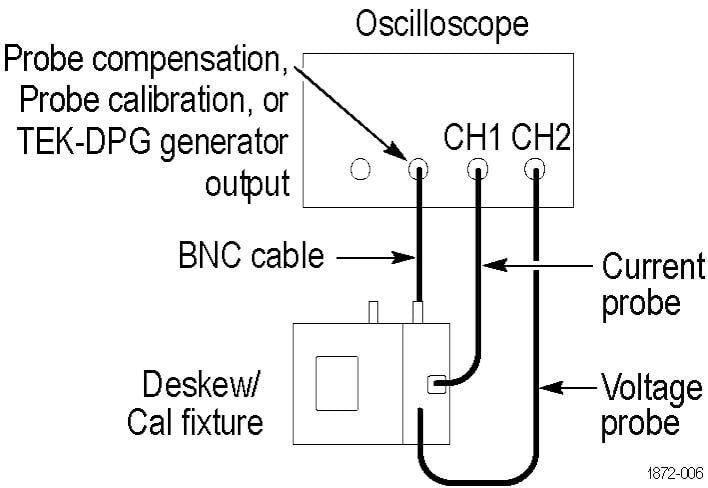
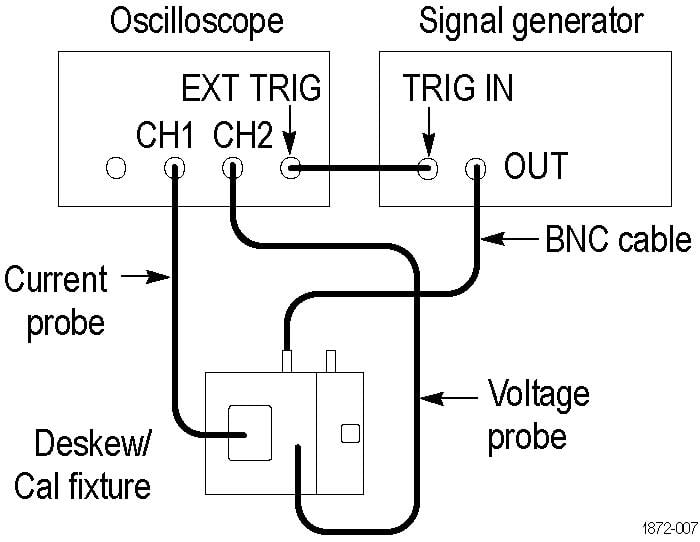
 | CAUTION:The maximum allowable voltage applied to either fixture input (Port A or Port B) is 8 V RMS. Voltages in excess of 8 V RMS may damage the fixture. |
Safety summary
To avoid potential hazards, use this product only as specified.
To avoid fire or personal injury, do not operate in wet/damp conditions.
Keep product surfaces clean and dry.
Refer to your probe manual for additional safety information.
Terms in this manual and on the product
These terms may appear in this manual:
 | WARNING:Warning statements identify conditions or practices that could result in injury or loss of life. |
 | CAUTION:Caution statements identify conditions or practices that could result in damage to this product or other property. |
These terms may appear on the product:
- DANGER indicates an injury hazard immediately accessible as you read the marking.
- WARNING indicates an injury hazard not immediately accessible as you read the marking.
- CAUTION indicates a hazard to property including the product.
Help us improve our technical documentation. Provide feedback on our TekTalk documentation forum.

